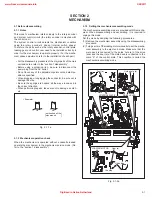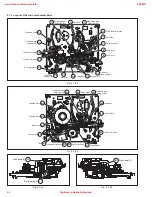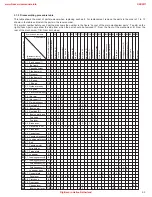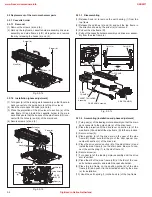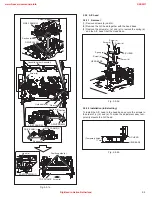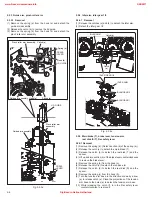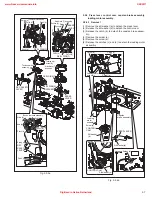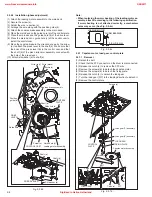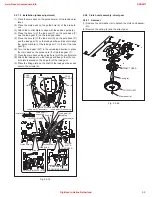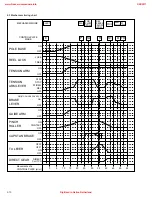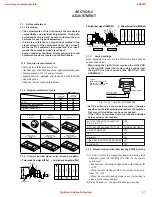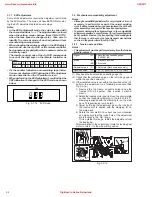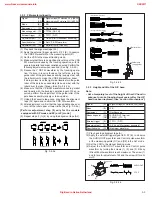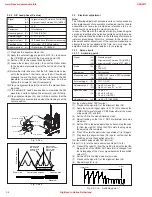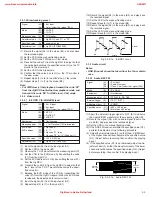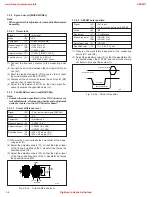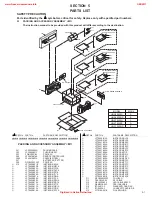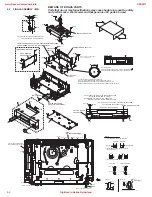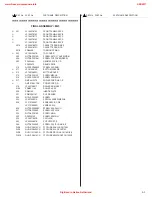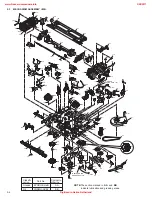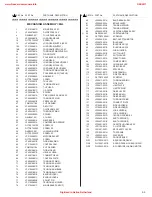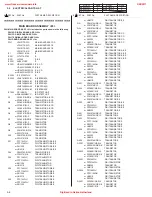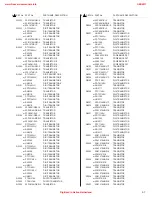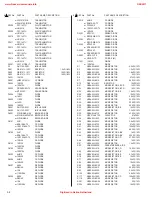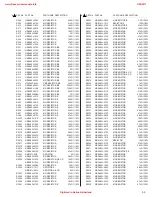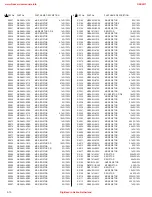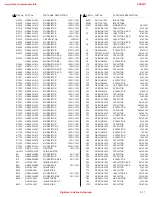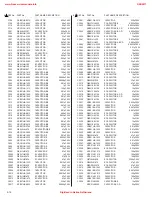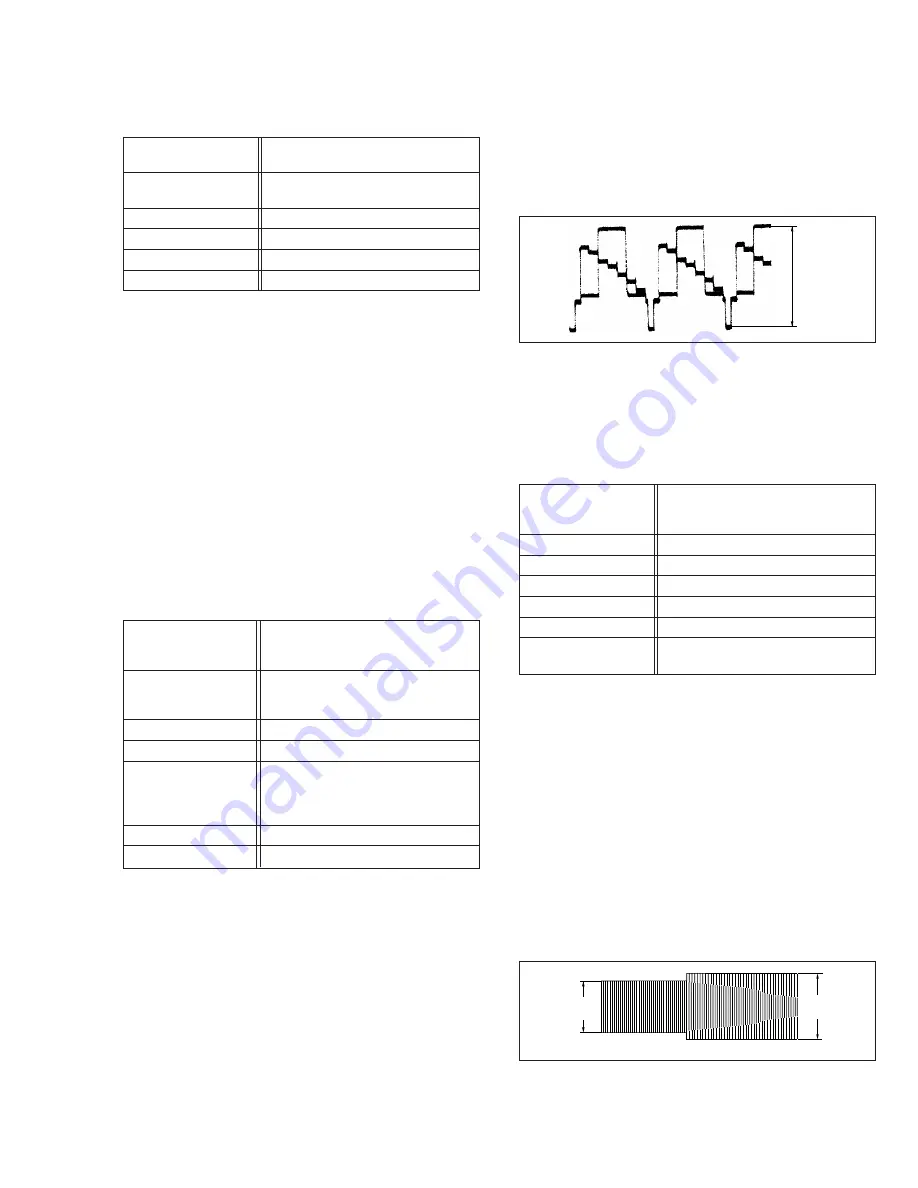
3-5
3.3.1.2 Slow tracking preset
Signal
(A1)
• Ext. input
(A2)
• Color (colour) bar signal [PAL]
Mode
(B1)
• VHS SP
(B2)
• VHS LP
Measuring point
(D)
• TV-Monitor
Adjustment part
(F)
• Jig RCU: Code “71“ or “72”
Specified value
(G)
• minimum noise
Adjustment tool
(H)
• Jig RCU [PTU94023B]
(1) Record the signal (A2) in the mode (B1), and play back
the recorded signal.
(2) Set the VCR to the manual tracking mode.
(3) Set the VCR to the FWD slow (+1/6x) mode.
(4) Transmit the code (F) from the Jig RCU to adjust so that
the noise bar becomes the specified value (G) on the TV
monitor in the slow mode.
(5) Set the VCR to the Stop mode.
(6) Confirm that the noise bar is (G) on the TV monitor in
the slow mode.
(7) Repeat steps (3) to (6) in the REV slow (–1/6x) mode.
(8) Repeat steps (1) to (7) in the mode (B2).
Note:
•
For FWD slow (+1/6x) playback, transmit the code “08”
from the Jig RCU to enter the slow playback mode, and
transmit the code “D0” for REV slow (–1/6x) mode.
Signal
(A1)
•
Ext. S-input
(A2)
•
Ext. input
(A3)
•
Color (colour) bar signal [PAL]
Mode
(B1)
•
EE SP
(B2)
•
S-VHS SP
(B3)
•
VHS SP
Equipment
(C)
•
Oscilloscope
Measuring point
(D)
•
Y OUT terminal (75
Ø
terminated)
EVR mode
(F1)
•
Jig code “57”
EVR address
(F2)
•
A : 11
(F3)
•
Jig code “21” twice
(F4)
•
Jig code “18” or “19” (C/-)
Specified value
(G)
•
1.00 ± 0.05 Vp-p
Adjustment tool
(H)
•
Jig RCU [PTU94023B]
Fig. 3-3-2-1a EE/PB Y level
H. rate
Y level
3.3.2 Video circuit
3.3.2.1 EE Y/PB Y (S-VHS/VHS) level
3.3.3 Audio circuit
Notes:
• GND (Ground) should be taken from the Tuner shield
case.
Signal
(A1)
•
Ext. input
(A2)
•
Audio: No signal
(A3)
•
Video: Color (colour) bar signal [PAL]
Mode
(B)
•
S-VHS LP
Equipment
(C)
•
Oscilloscope
Measuring point
(D)
•
TP2253 (A. PB. FM)
External trigger
(E)
•
TP111 (D.FF)
Adjustment part
(F)
•
VR2251
Specified value
(G1)
•
600 ± 100 mVp-p
(G2)
•
More than 400 mVp-p
(1) Apply the external trigger signal to D.FF (E) to observe
the Audio PB FM waveform at the measuring point (D).
(2) Record the signal (A3) with no audio signal input in the
mode (B), and play back the recorded signal.
(3) Set the VCR to the manual tracking mode.
(4) If the A.PB FM level is not within the specified value (G1),
perform the adjustment in a following procedure.
(5) Adjust the Adjustment part (F) so that the A. PB FM level
of the higher channel level becomes the specified value
(G1). (Adjust before recording, then confirm it by playing
back.)
(6) If the specified value (G1) is not obtained, adjust the Ad-
justment part (F) so that the waveform level of the lower
channel level becomes the specified value (G2). (Adjust
before recording, then confirm it by playing back.)
3.3.3.1 Audio REC FM
Fig. 3-3-3-1a Audio REC FM
V. rate
Specified
value (G1)
Specified
value (G2)
(1) Input the signal (A3) from the input point (A1).
(2) Set the VCR to the mode (B1).
(3) Observe the Y OUT waveform at the measuring point (D).
(4) Set the VCR to the EVR mode by transmitting the code
(F1) from the Jig RCU.
(5) Set the EVR address to (F2) by transmitting the code (F3)
from the Jig RCU.
(6) Transmit the code (F4) from the Jig RCU to adjust so that
the Y level of the Y OUT waveform becomes the speci-
fied value (G).
(7) Release the EVR mode of the VCR by transmitting the
code (F1) from the Jig RCU again. (When the EVR mode
is released, the adjusted data is memorized.)
(8) Input the signal (A3) from the input point (A2).
(9) Repeat steps (3) to (7) in the mode (B1).
(10) Record the signal (A3) in the mode (B2), and play back
the recorded signal.
(11) Set the VCR to the manual tracking mode.
(12) Repeat steps (3) to (7) in the mode (B2).
(13) Record the signal (A3) in the mode (B3), and play back
the recorded signal.
(14) Set the VCR to the manual tracking mode.
(15) Repeat steps (3) to (7) in the mode (B3).
www.freeservicemanuals.info
3/28/2017
Digitized in Heiloo Netherland

